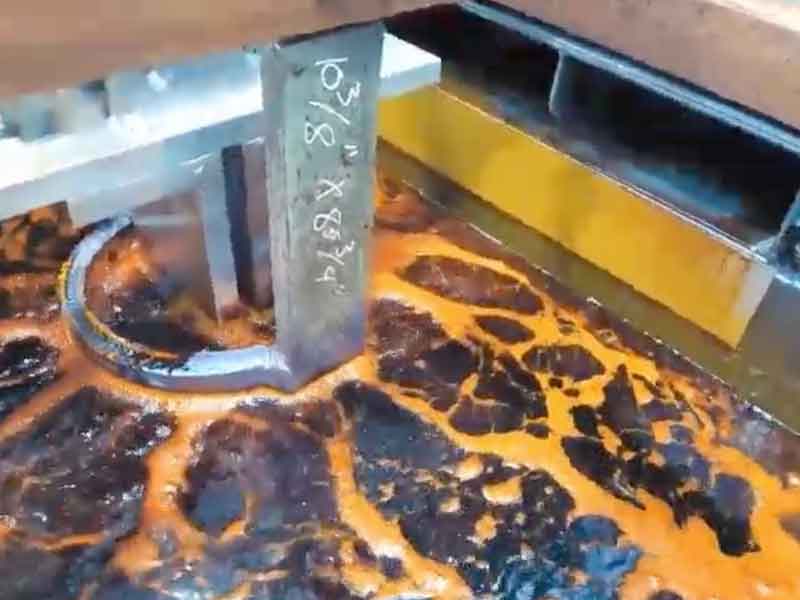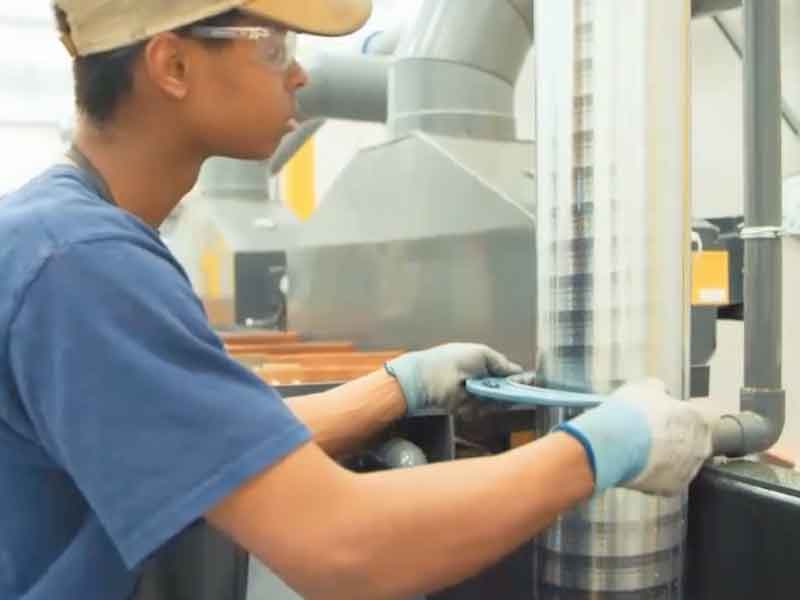No one is questioning the effectiveness that hexavalent chromium has for its hardness, wearability, and even for preventing corrosion on critical metal parts.
 Eric Svenson Sr.But Eric Svenson Sr., President of chemical and equipment supplier Plating Resources in Cocoa, Florida, does question whether most electroplaters are using the proper system when using hex chrome that avoids EPA and OSHA violations.
Eric Svenson Sr.But Eric Svenson Sr., President of chemical and equipment supplier Plating Resources in Cocoa, Florida, does question whether most electroplaters are using the proper system when using hex chrome that avoids EPA and OSHA violations.
Svenson says his company has developed a proprietary processing system for hex chrome that allows plating shops to use it without the worry of hazards to their employees or being in violation of any local, state, and federal guidelines.
New Hex Chrome System in Virginia
In fact, Plating Resources recently installed a new hex chrome system in Virginia for a subsidiary of Caterpillar that passed all air quality regulations in independent testing. It all came down to a unique way of installing and running the system, which has near net-zero chromium discharges.
“I wouldn’t say platers are doing it wrong, as that’s the way it has been done for decades,” Svenson says. “It’s just that there’s now a better way to design a hard chrome system if the goal is producing a high-quality product in a cost-effective manner while also ensuring ongoing environmental and worker safety compliance.”
Svenson says the environmental issue with hex chrome starts with the gassing generated during the electrolysis cycle. The DC energy that doesn’t deposit Cr generates H & O gassing, in which bubbles rise and break at the bath’s surface, causing the chrome mist that is drawn into the exhaust hoods and collects on the tank rims and around the shop.
The mist that escapes the hood exposes the workers to breathing Cr contaminated air.
“The reason for this is conventional chrome baths only operate at around 18%-20% efficiency,” Svenson says. “This means that 80% of the DC energy is wasted in producing excess gassing.”
7-Steps to Sustainable Hard Chrome
 That led Plating Resources to develop a proprietary “7-Steps to Sustainable Hard Chrome” process that uses a “Triple-Catalyst” system that has a much greater electrical efficiency, which Svenson says is upwards of 35%. He says the result is 50% faster plating and greater production ability.
That led Plating Resources to develop a proprietary “7-Steps to Sustainable Hard Chrome” process that uses a “Triple-Catalyst” system that has a much greater electrical efficiency, which Svenson says is upwards of 35%. He says the result is 50% faster plating and greater production ability.
“From an environmental standpoint, it means much less gassing that the ventilation system and the workers have to deal with,” Svenson says. “That’s Step No. 1; less gassing equals less pollution to deal with.”
The other factors involving the Plating Resources equipment/system design include:
- A special rinsing system to reduce the overall water volumes used, which allows all rinse water to be returned to the system for reuse which reduces their chemical costs.
- A unique bath agitation system that does not create additional Cr-misting like air agitation does that can overload the scrubber.
- A different design for the ventilation system that’s a significant improvement in the Cr removal efficiency compared to typical scrubbers. Svenson says the ventilation design captures virtually 100% of the chrome misting, which keeps the plant clean and the workers safe. The system then condenses this mist back into liquid chrome that is returned to the process for reuse, which saves on chemical costs. Svenson also says the ventilation system is so efficient that expensive fume suppressants aren’t needed to retard the fuming, which further lowers the operational costs while also improving the Cr deposit quality due to gas suppression and pitting.
- A special containment system is used to house the entire plating area that allows chemical or liquid spills and any tank overflow to be captured and segregated by chemical type. The containment is normally dry, Svenson says, but any such liquids can easily be filtered directly back into the appropriate tank for reuse, and there is no need to treat these spills as a waste products.
20 Years of Research and Development
 A technician at Carter Machinery checks the final chrome coating.Svenson says the development of this process by Plating Resources started around 1990 on a lab scale but wasn’t confirmed in the “real world” until now because companies weren’t installing new hard chrome operations.
A technician at Carter Machinery checks the final chrome coating.Svenson says the development of this process by Plating Resources started around 1990 on a lab scale but wasn’t confirmed in the “real world” until now because companies weren’t installing new hard chrome operations.
In 2021, they were able to convince Carter Machinery Co. in Mechanicsville, Virginia, that hex chrome could be safely applied to their hydraulic components using the 7-Step Process.
Founded in 1927, Carter Machinery became the largest dealer in Caterpillar equipment in the United States, and it was acquired by Caterpillar in 1988. Plating Resources added an in-house hex chrome line that gives them the ability to chrome hydraulic cylinder rods in their chrome shop so they can get machines back up and running faster.
“We designed their plating system, handled the equipment fabrication, oversaw the entire system installation, installed their laboratory, and even trained their employees,” Svenson says. “Keep in mind that none of their employees had any prior plating experience. This meant there were no bad habits to break as all the workers were starting from scratch.”
Passing Tests Plating at 20,000 DCA for 8 Hours
Source testing at the Carter Machinery facility was done for the Virginia Department of Environmental Quality by Montrose Air Quality Services in Roanoke, and the results confirmed the viability of this system design by plating at 20,000 DCA for 8-straight hours:
- The hex chrome stack air discharge was essentially zero or below detectable limits.
- There was no liquid waste, as everything was recycled for reuse. There were no sewer connections, and waste treatment wasn’t needed.
- The workers tested between 55-and 155 times below the OSHA Cr PEL limit without having to wear protective equipment or use a fume suppressant.
- The shop stayed dry and clean of hex chrome misting, including the tank rims, the hoods, and the shop floor.
“The 7-Step design fits in perfectly with a new installation where we have the ability to design the equipment properly into a functional system,” Svenson says. “It can also be adopted to existing hard chrome operations for companies looking to upgrade their equipment and processes.”
Plating Resources was founded in 1931 by George Benhard Svenson Sr., in Cleveland, Ohio, as Platers Supply, where he bought various chemicals, acids, and cyanides from a distributor and sold them to local plating shops in the city. His son, George Benhard Svenson Jr., followed in his father’s footsteps in 1933 with the company.
Focused on the Hard Chrome Industry
 Eric Svenson Jr.Eric Svenson Sr., George Jr.’s son, joined the company in 1961. He developed their Micro Tuff product in 1991 that is manufactured in-house and eventually moved the company to Florida. His son, Eric Jr., joined the company as Technical Director in 2019.
Eric Svenson Jr.Eric Svenson Sr., George Jr.’s son, joined the company in 1961. He developed their Micro Tuff product in 1991 that is manufactured in-house and eventually moved the company to Florida. His son, Eric Jr., joined the company as Technical Director in 2019.
“Around 1980, we focused our technology almost exclusively on the hard chrome industry,” Svenson Sr. says. “It was mainly because I perceived it to be the most interesting and challenging, especially considering all the special techniques involved.”
Svenson Jr. says the trend of sustainable hard chrome is expected to grow as companies realize just how safely and inexpensively chrome can be applied.
“There’s no longer a need to replace hex chrome with more expensive coatings,” he says. “Those who adopt Sustainable Hard Chrome can rest easy that our environment is being protected. This technology can make them more competitive while also driving more business their way.”
Svenson Sr. says shops can meet safety regulations for using hex chrome by using a high-efficiency triple-catalyst plating bath and an improved agitation system. The next step is to upgrade the tank configurations and ventilation system, using a segregated containment system, segregated ventilation systems, the special rinsing process, and the application of zero discharge recovery.
Near Net-Zero Chromium Discharges
“No one has a crystal ball to predict where the future discharge regulations will go,” he says. “However, if history is any indicator, there’s a good chance they will be lowered even more. Any such regulatory tightening will further damage this critical industry by eliminating those operations that are unable to comply.”
He says the Carter Machinery project has proven that it is possible to design and operate a high production hex chrome plating system with near net-zero chromium discharges and to do it in a cost-efficient manner.
“The regulatory agencies can lower the limits to whatever numbers they want, but they can never go to zero and still maintain any resemblance of industry in America,” Svenson Sr. says. “Carter Machinery is a hard chrome plater that is already at the zero level. Therefore, they are prepared for whatever the future may hold as it applies to not only their stack emissions but also their process liquids and the safety of their personnel.”
Visit https://plating.com



































